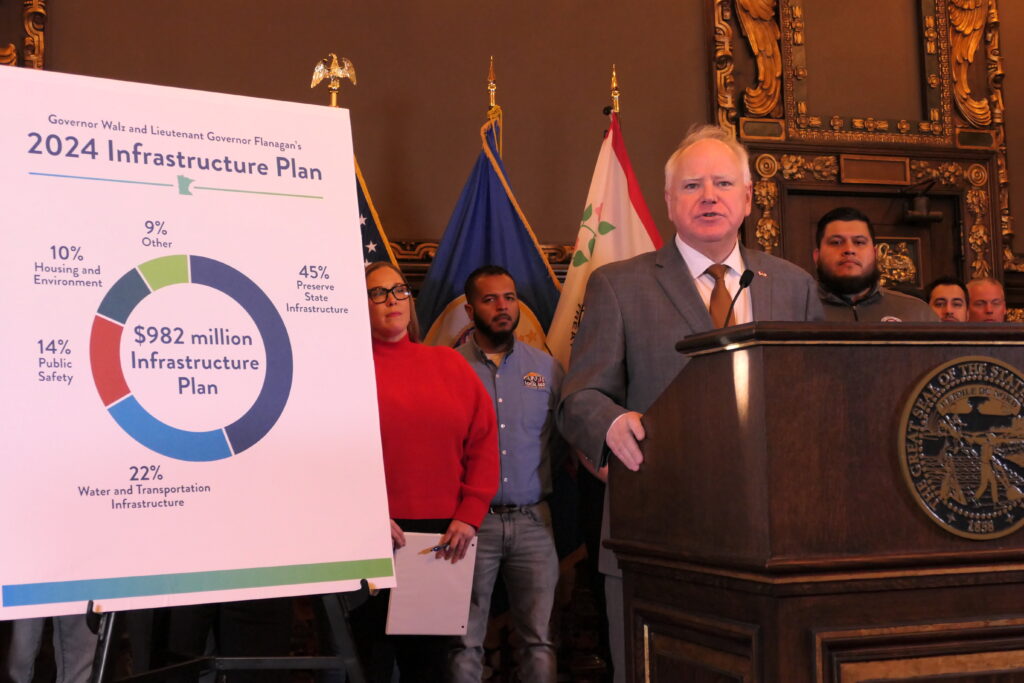
Michelle Griffith/Minnesota Reformer – Gov. Tim Walz on Tuesday proposed spending nearly a billion dollars to update the state’s roads, improve public safety and protect Minnesota’s drinking water, among many other projects.
Walz’s $982 million public works proposal comes about eight months after the Minnesota Legislature approved the largest infrastructure package in the state’s history. Lawmakers approved a $2.6 billion infrastructure bill — known around the Capitol as a bonding bill because the state typically relies on borrowed money — after a split Legislature had stalled critical public works spending for two years.
Infrastructure packages are normally passed during even years, which also happen to be election years, when candidates can brag about bringing projects home to their districts. Walz said his nearly $1 billion proposal — $819 million in general obligation bonds, the rest in other financing and cash — will move the state into “the golden age of construction and infrastructure in Minnesota.”
Walz highlighted the plan’s focus on keeping intact Minnesota’s vast public assets. “Another key part of this plan is going to be preserving what we already have. The infrastructure in the state from corner to corner is our greatest asset,” Walz said. “It also is irresponsible to not make sure you’re keeping up the maintenance on those.”
Nearly half of Walz’s proposed funding is allocated toward maintenance on existing infrastructure.
Walz’s plan also includes some new construction, like new public safety buildings and water infrastructure projects. For example, Walz proposed $48 million for a new Bureau of Criminal Apprehension regional office and laboratory in Mankato, his hometown. He’s also proposing $22 million for a new headquarters building for the State Patrol.
Last year’s package included $1.5 billion in borrowing through bonds, requiring a legislative supermajority, while about $1.1 billion was funded through cash.
Republicans leveraged their needed votes to stall the bonding bill and advocate for more nursing home funding. Republicans and the DFL-majority agreed in the final days of the session to an extra $300 million for nursing homes.
Given the size of the infrastructure bill last year, Republicans will likely drive a hard bargain again once the session begins on Feb. 12, especially with 134 House seats up for election in November.
State Sen. Karin Housley, R-Stillwater, said in a statement that she is still gathering information about Walz’s plan. She offered an opening salvo in what will likely be a months-long negotiation, however: “I am concerned there isn’t more money in this proposal for local needs across the state. Wastewater treatment and crumbling roads might not be glamorous, but they are the basic necessities that every community needs to thrive.”
With the governor’s relatively restrained plan — he proposed a $3.3 billion package last year — Walz may be attempting to ease political pressure on DFL lawmakers. Republicans are hitting Democrats hard over the state borrowing $454 million to upgrade the State Office Building, which houses the secretary of state and the offices of the 134 House members.
Minnesota Management and Budget Commissioner Erin Campbell wrote in a letter to lawmakers that the state currently has over $7.6 billion in requests — $4.7 billion in state agency requests and $2.9 billion from local governments.
To see a full list of the governor’s proposed infrastructure projects, visit MMB’s website here.
